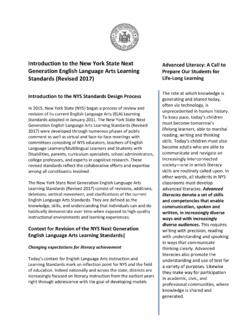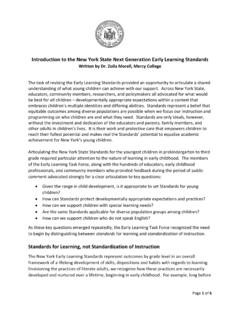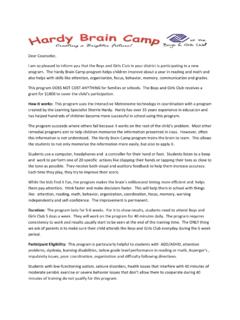Transcription of An Introduction to the New World Kirkpatrick Model
1 An Introduction to the New World Kirkpatrick Model Jim Kirkpatrick , Wendy Kirkpatrick Copyright notice Copyright 2010-2019 Kirkpatrick Partners, LLC. All rights reserved. This article may be used internally within the company of the program participant only. No part of this publication may be reproduced, distributed, posted, shared, or transmitted in any form or by any means, including photocopying, recording, web posting, blogging, or other electronic or mechanical methods, for the purpose of soliciting business, creating educational materials, hosting seminars, or otherwise profiting from the contents, without the prior written permission of the author. For permission requests, write to: Kirkpatrick Partners, LLC (770) 302-3500 8 Madison Street, Suite C Newnan, GA 30263 The following marks are the property of Kirkpatrick Partners, LLC: Kirkpatrick Blended Evaluation Kirkpatrick Four Levels BrightLight The One and Only Kirkpatrick January 2019 3 An Urgent Need to Evaluate Training Around the World , training and development is in a state of crisis.
2 Training budgets are among the first to be cut when economic times get tough. Whether you re one of the in-house survivors or a struggling consultant, you can no longer coast on lofty notions about continuous learning and employee development. You need to provide compelling evidence that training delivers bottom-line results and contributes to mission accomplishment. Training must reinvent itself and transcend the classroom to earn its budget and maintain its existence. Savvy business professionals and enlightened organizations know that training has no value unless what is learned gets applied on the job, and the subsequent on-the-job performance contributes to key organizational outcomes. The New World Kirkpatrick Model will show you how to create an effective training evaluation plan for any program so that you can show the organizational value of your work.
3 At the same time, an effective plan will ensure that your valuable, limited resources are dedicated to the programs that will create the most impact. Employing these principles to your work will earn you a seat at the proverbial table with business executives and secure your future as a valuable resource and key partner in accomplishing organizational results. Why Evaluate? Most training professionals are accustomed to evaluating training programs for the purpose of improving the program. Using formative (during the program) and summative (after the program) methods, they ask questions related to how participants enjoyed the program, whether they learned key information and how the program might be improved for future sessions. This type of information is useful to learning and performance professionals to gauge the quality of their training programs, materials and presenters.
4 If There are three major reasons to evaluate training programs: To improve the program To maximize transfer of learning to behavior and subsequent organizational results To demonstrate the value of training to the organization 4 THE Kirkpatrick Model evaluation of the training program shows that the program was well-received and key information was learned, then the program can be called effective training. More savvy training professionals realize that even the most well-designed and well-received training programs are of little use unless what is learned in training gets implemented on the job. This is often called the transfer of learning to behavior. If what was learned translates into improved job performance, then it is possible for better organizational results to be achieved. If training evaluation shows that on-the-job performance increased and results improved, then training effectiveness has occurred.
5 Finally, learning and performance professionals must be able to show the organizational value of their training. Like any other department in an organization, training is not exempt from showing how the resources allocated to them have been put to use. By gathering data related to effective training and training effectiveness, learning and performance professionals can credibly show the value that training has brought to the organization. The New World Kirkpatrick Model honors and maintains the time-tested four levels and adds new elements to help people operationalize it effectively. We begin with Level 4, as this is the way the Model was intended. The degree to which targeted outcomes occur as a result of the training and the support and accountability package The degree to which participants apply what they learned during training when they are back on the job The degree to which participants acquire the intended knowledge, skills, attitude, confidence and commitment based on their participation in the training The degree to which participants find the training favorable, engaging and relevant to their jobs 5 The New World Kirkpatrick Model All you need to do is show that your training is effective and that it has created training effectiveness.
6 Sounds simple, doesn t it? But, how can this be done, especially with limited time, money and resources? A simple and time-tested Model for accomplishing this is the Kirkpatrick Model , or the four levels. Level 4: Results Level 4 holds the distinction of being the most misunderstood of the four levels. It is the degree to which targeted outcomes occur as a result of the learning event(s) and subsequent reinforcement. A common misapplication occurs when professionals or functional departments define results in terms of their small, individual area of the organization instead of globally for the entire company. This creates silos and fiefdoms that are counterproductive to organizational effectiveness. The resulting misalignment causes layers upon layers of dysfunction and waste. Clarity regarding the true Level 4 Result of an organization is critical.
7 By definition, it is some combination of the organizational purpose and mission. In a for-profit company, it means profitably delivering the product or service to the marketplace. In a not-for-profit, government or military organization, it means accomplishing the mission. Every organization has just one Level 4 Result. A good test of whether or not the correct Level 4 Result has been identified is a positive answer to the question, Is this what the organization exists to do / deliver / contribute? 6 While this definition of results is straightforward, frustration with the seeming inability to relate a single training class to a high-level organizational mission is common. Business results are broad and long term. They are created through the culmination of countless efforts of people, departments and environmental factors. They can take months or years to manifest. Leading Indicators Leading indicators help to bridge the gap between individual initiatives and efforts, and organizational results.
8 They are defined as short-term observations and measurements that suggest that critical behaviors are on track to create a positive impact on the desired results. Organizations will have a number of leading indicators that encompass departmental and individual goals, each contributing to the accomplishment of the highest-level results. Common leading indicators include: Customer satisfaction Employee engagement Sales volume Cost containment Quality Market share While leading indicators are important measurements, they must be balanced with a focus on the highest-level result. For example, a company with excellent customer satisfaction scores could go out of business if it does not maintain profitability, comply with laws and regulations and keep its employees reasonably happy. Note that customer satisfaction is an example of a goal that does not provide an affirmative answer to the question, Is this what the organization exists to contribute?
9 No organization exists simply to deliver customer service alone. Level 3: Behavior Level 3 is the degree to which participants apply what they learned during training when they are back on the job. The New World Level 3 Behavior consists of critical behaviors, required drivers and on-the-job learning. Critical Behaviors Critical behaviors are the few, specific actions, which, if performed consistently on the job, will have the biggest impact on the desired results. 7 Active execution and monitoring of required drivers is perhaps the biggest indicator of program success for any initiative. There are perhaps thousands of behaviors a given employee might perform on the job; critical behaviors are those that have been identified as the most important to achieving organizational success. Required Drivers The New World Kirkpatrick Model adds required drivers to Level 3. Required drivers are processes and systems that reinforce, monitor, encourage and reward performance of critical behaviors on the job.
10 Common examples of required drivers include job aids, coaching, work review, pay-for-performance systems and recognition for a job well done. Required drivers are the key to accomplishing the desired on-the-job application of what is learned during training. They decrease the likelihood of people falling through the cracks, or deliberately crawling through the cracks if they are not interested in performing the required behaviors. Organizations that reinforce the knowledge and skills learned during training with accountability and support systems can expect as much as 85% application on the job. Conversely, companies that rely primarily on training events alone to create good job performance achieve around a 15% success rate (Brinkerhoff, Telling Training s Story, 2006). On-the-Job Learning On-the-job learning is part of the New World Level 3 in recognition of two facts of the modern workplace: 1.












